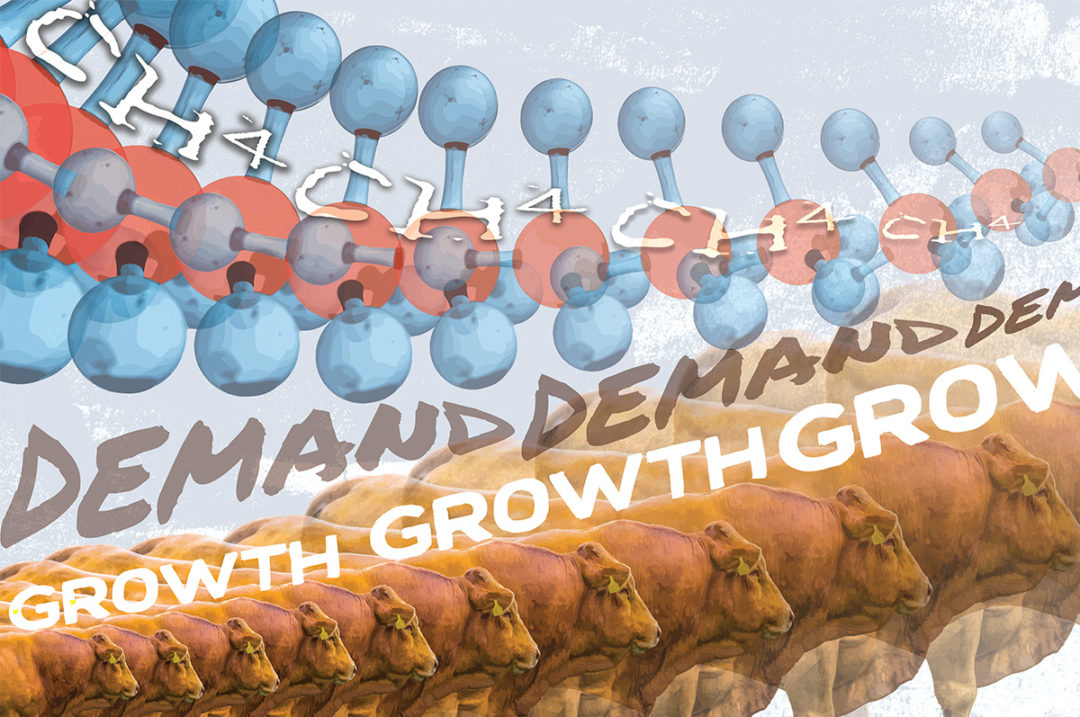When Myles Allen, a professor of geosystem science at the University of Oxford, talks, I always suggest it’s worth a listen – particularly when he shares information that can help improve sustainability in the cattle sector.
When he spoke at CattleCon in February, his message – although rooted in complex science and based on complicated mathematical calculations – was as plain as day.
“Emissions … from the U.S. livestock sector have caused very little additional warming since 1990,” he said.
Let’s be clear: We need to ensure we do not increase emissions and reduce emissions as we can. We can gain efficiencies by doing so and help meet increasing demand while limiting environmental impact.
So why is animal agriculture – and particularly the beef and dairy sectors – constantly taking it on the chin for methane emissions? Why do people think giving up animal-source foods will save us from climate change? There isn’t just one reason, but one important reason is that for a long time, we looked at methane through the wrong lens. Our yardstick for measuring the warming potential of greenhouse gases was GWP100, where methane is treated as if – in Allen’s words – “it’s a form of carbon dioxide” that continues to cause warming indefinitely like CO2 does.
In fact, it doesn’t. Unlike carbon dioxide, a stock gas and long-lived climate pollutant, methane is a flow gas with a short lifespan. True, it is more potent than carbon dioxide, but only for the first decade after it’s emitted. Beyond that, it’s broken down into CO2 and water vapor.
To their credit, Allen and his team at Oxford realized the shortcomings of GWP100 and went to work to develop a metric that gives us a far more accurate picture of the warming caused by methane. The result is GWP*, which has clarified and revolutionized the way we look at methane emissions and, even more importantly, allowed us to target it more effectively.
However, it is not without controversy. Heated discussions are arising over the fact that GWP* may be scientifically correct but nevertheless unfair to use.
Certain groups dislike GWP* because it shows that animal agriculture can meet demand and significantly reduce its climate impact by committing to strong methane reductions. These groups are often those that want to see less animal agriculture, period.
Other naysayers believe GWP* gives a pass to developed regions with advanced livestock sectors. Here’s why: Producers in developed nations have been producing animal-source foods (and emitting methane) for a long time. For example, the U.S. is the world’s leading beef producer, contributing 18% of the world’s beef with 6% of the world’s beef cattle. Therefore, our farmers are understandably responsible for a large volume of methane emissions. That said, emissions and output are relatively stable, a result of efficiencies and relatively low population growth compared to developing regions.
For U.S. farmers and ranchers and many in other developed regions, production isn’t increasing dramatically because population and corresponding demand for animal-source foods are more stable than they are in developing regions. Thus, GWP* can make high emitters look like they aren’t impacting current temperatures, provided they keep their emissions constant. And if they can reduce emissions (which we know is possible), they will look like superheroes.
On the other hand, many developing regions are experiencing significant human population growth and corresponding increases in demand for animal-source foods to better their nutrition. To score a GWP* win, these producers must cut emissions at the same time they are being asked to produce more animal-source food to feed rapidly growing populations. To further complicate the scenario, these farmers have historically been less efficient than those in the U.S., for instance. Their carbon footprint per glass of milk or ounce of meat is higher than it is for U.S. ranchers and farmers. Thus, increasing output in developing regions will come at a higher emissions price relative to regions that have more advanced animal agriculture systems.
No credible sources debate the physics behind GWP*, yet questions about its applicability and fairness in the real world are legitimate. As Allen rightly pointed out at CattleCon, if emissions are stable, what is put up in the atmosphere can equal what is sunk in the atmosphere, and there is no additional warming.
In the same vein, if we emit less methane than is naturally being broken down, we’ll reduce warming. If we up our methane emissions, we’ll add warming. And given that methane packs a punch, we’ll add a lot of warming.
There’s a message here. Methane gives us a lot of bang for our buck. We can quickly impact global temperatures by managing it. Carbon dioxide, the No. 1 greenhouse gas by far, doesn’t give us that opportunity.
No one is advocating that we need to stop worrying about methane or give it a pass. We can embrace GWP* and still work on ways to do better by it. Consider these facts:
- Methane is responsible for about one-third of all human-caused warming. We need to reduce it. Significantly.
- Sectors such as animal agriculture that primarily emit methane can reach climate neutrality much easier than CO2-producing sectors simply by having stable emissions. But – and this is the truth I want to get to – that doesn’t give anyone a free pass. In fact, sectors that produce methane can eat into their historic emissions by reducing beyond stable levels. There are tools coming online to help certain sectors do that. We should encourage their adoption and give producers credit for doing so.
- Two things can be true at once. You can protest animal agriculture, and GWP* can be accurate.
- We can reduce methane on farms and continue to have a high yield.
- We can’t lose focus on reducing carbon dioxide. It’s stockpiling in the atmosphere, continuously heating our planet for hundreds and thousands of years, if not forever.
- Arguments against GWP* are rooted in fears that it lets agriculture sectors off the hook if their emissions are stable and that it penalizes those with growing sectors. In other words, countries that have been big-time producers and emitters historically could continue to produce and emit at a high level and claim to have a minimal impact on global temperatures, or they could make some minor cuts and proclaim victory. But this isn’t the fault of GWP*. How we use it is key, and that’s a critical conversation to have.
If we are telling producers their efforts to feed us are exacerbating climate change, they deserve to know how their actions to reduce emissions are impacting the climate. I believe showing the effect reductions have will encourage further solutions and adoption of those solutions. In addition to feeding us, farmers and ranchers are stewards of our lands.
I think we’re smart enough to use the GWP* metric in ways that drive us to reduce warming without granting established sectors a free pass or penalizing those that are growing theirs. A one-size-fits-all approach isn’t appropriate as we look to tackle the environmental impact of production in a diversity of regions.
At the end of the day, one fact is irrefutable, regardless of which side of the argument you’re on: We will need to produce more food, and we will need to do it better than ever before.






